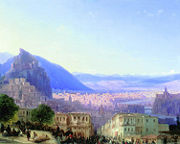
Old Tbilisi
Encyclopedia

Tbilisi
Tbilisi is the capital and the largest city of Georgia, lying on the banks of the Mt'k'vari River. The name is derived from an early Georgian form T'pilisi and it was officially known as Tiflis until 1936...
, capital of Georgia
Georgia (country)
Georgia is a sovereign state in the Caucasus region of Eurasia. Located at the crossroads of Western Asia and Eastern Europe, it is bounded to the west by the Black Sea, to the north by Russia, to the southwest by Turkey, to the south by Armenia, and to the southeast by Azerbaijan. The capital of...
. Although the term "Old Tbilisi" has long been used to denote a historical part of the city, it was only in 2007 that it became a distinct administrative entity to incorporate several historical neighborhoods formerly included in the districts of Mtatsminda-Krtsanisi, Isani-Samgori, and Didube-Chughureti.
Old Tbilisi is principally centered on what is commonly referred to as the Tbilisi Historic District, which, due to its significant architectural and urban value, as well as the threat to its survival, was previously listed on the World Monuments Watch
World Monuments Fund
World Monuments Fund is a private, international, non-profit organization dedicated to the preservation of historic architecture and cultural heritage sites around the world through fieldwork, advocacy, grantmaking, education, and training....
(1998, 2000, 2002).
The district is located on the both sides of the Mtkvari River and is dominated by Mount Mtatsminda, Narikala
Narikala
Narikala is an ancient fortress overlooking Tbilisi, the capital of Georgia, and the Kura River. The fortress consists of two walled sections on a steep hill between the sulphur baths and the botanical gardens of Tbilisi. On the lower court there is the recently restored St Nicholas church.The...
fortress and the Kartlis Deda
Kartlis Deda
Kartlis Deda is a monumental statue in Georgia’s capital Tbilisi which has become one of the symbols of the city.It was erected on the top of the Sololaki hill in 1958 when Tbilisi celebrated its 1500-year anniversary. The author of this twenty meter high aluminum figure of a woman in Georgian...
monument. It chiefly represents a 19th-century urban fabric with largely eclectic architecture which includes the buildings and structures from the 5th to the 20th century. However, most of the pre-19th century city did not survive due to the devastating Persian invasion of 1795
Battle of Krtsanisi
The Battle of Krtsanisi was fought between Persian and Georgian armies at the place of Krtsanisi near Tbilisi, Georgia, from September 8 to September 11, 1795, as part of the war intended by the Persian ruler Agha Mohammad Khan Qajar as a reprisal for King Heraclius II of Georgia’s alliance with...
. The district houses a bulk of the tourist attractions in Tbilisi, including churches, museums, sulphur bathhouses, and peculiar wooden houses with open, carved balconies. In the 19th century, the core territory of the modern-day district of Old Tbilisi was tentatively subdivided into ethnic neighborhoods such as Avlabari
Avlabari
Avlabari is a neighborhood of Old Tbilisi on the left bank of the Kura River. The 11th-13th century chronicles mention it as Isani, which is now one of the larger municipal regions of Tbilisi...
with its Armenian and Georgian quarters, Alexanderdorf German quarter on the left bank of the Kura River and the Persian Quarter (Said-Abad) on the right bank of the Kura River.
External links
- Old Tbilisi Official Website Old Tbilisi. The Government of Tbilisi.
- Tbilisi Project. Heritage and Modernity Association.
- Tbilisi History Museum. Georgian Art Portal.
- Old Tbilisi (vintage photos). Georgian Photographical Heritage Research Center.

